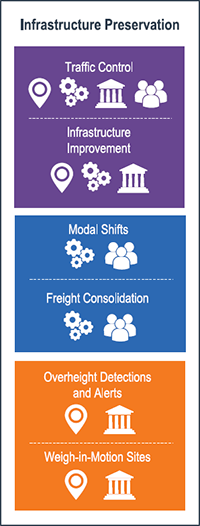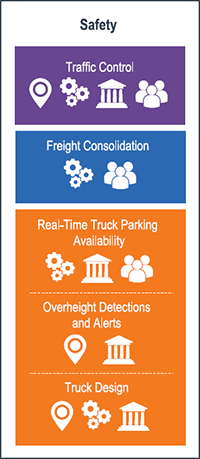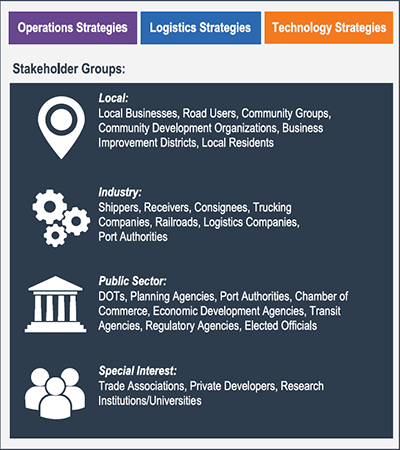Primer for Improved Urban Freight Mobility and Delivery
Operations, Logistics, and Technology Strategies
Noteworthy Practice Success Factors
The noteworthy practices featured in Sections 3, 4, and 5 highlight strategies geared towards improving urban freight mobility through OLT applications. Although each noteworthy practice presents distinct challenges and solutions, several common factors contributed to the success of the program or initiative. The primary success factors for OLT strategies include:
- Engage stakeholders. Stakeholder engagement can be critical for understanding local needs and implementing appropriate solutions. The San Francisco Municipal Transportation Agency (SFMTA) actively manages loading zone designations, holding monthly public hearings and rapidly processing requests for new loading zones or changes to existing loading zones. In New Orleans, the French Quarter Management District worked with the City Council to pass legislation banning oversized vehicles from accessing the historic French Quarter neighborhood. The popularity of the oversized vehicle ban among New Orleans residents has led to additional law enforcement hires through the French Quarter Task Force. The Downtown DC Business Improvement District worked closely with the District DOT to implement and evaluate a pilot parking program that led to citywide changes in the management and enforcement of loading zones. This approach fostered partnerships with stakeholders to communicate the intention of the changes to loading zone rules and to achieve mutually beneficial outcomes.
- Partner with the private sector. Given the dominant role of the private sector in freight transport, private-sector participation is vital for successful implementation of new urban freight initiatives. Private-sector stakeholders can offer insights into freight challenges and potential solutions that are based on their "real world" experience operating in urban environments. In many noteworthy practices, program managers collaborated with private-sector freight stakeholders to ensure proper implementation. In the case of the Port Authority of New York and New Jersey, the agency worked with the private sector to develop appropriate commercial design guidelines for the World Trade Center complex and the implementation of the Campus Security Plan. The approach developed has helped to streamline secure deliveries to the complex. The Houston-Galveston Area Council partnered with UPS to pilot a deployment of 18 all-electric delivery vehicles to reduce fuel consumption and emissions. These examples showcase the importance of coordinating with the private sector to achieve successful implementation of an OLT strategy.
- Partnering with enforcement agencies. In cases where a public agency implemented a new policy or regulation, ensuring strong enforcement has been critical to their success. When the City of Miami Beach developed its loading zone permitting system, it established a comprehensive enforcement approach to cite both drivers obstructing traffic and businesses accepting deliveries outside loading zone hours. This strategy holds both the vehicle operator and the business receiving the freight accountable for vehicle violations and has led to reduced double parking and helped decrease traffic congestion. Similarly, in New Orleans, efforts to ban large trucks from the French Quarter required additional investment in enforcement to have an effect. Rigorous enforcement of Federal Clean Truck Emissions Standards ensured the success of the Port of Los Angeles and Port of Long Beach Clean Trucks Program, which reduced emissions from drayage by 80 percent. Strong enforcement is critical to ensuring that an OLT program or policy is successful in meeting its goals for urban freight mobility.
- Work with port authorities. Ports in metropolitan areas can be significant sources of commercial truck traffic. A number of the strategies documented in this Primer demonstrate how cities can work with port authorities to reduce emissions, mitigate noise, and preserve infrastructure by changing the way shipments move in and out of ports. The Port of New Orleans has worked to shift some shipments from truck to barge that will save the State of Louisiana significant roadway maintenance costs. The Massachusetts Port Authority (Massport) worked with the City of Boston to develop and build a dedicated freight roadway that removed 900 truck trips per day from local roads in and around Conley Terminal in South Boston.
- Foster cooperation through sharing information and/or benefits. Under London's Construction Logistics Program, developers share information about expected construction traffic with local officials prior to the start of construction, allowing local officials to assess traffic impacts and negotiate reductions in vehicle trips. The New York City WIM project shows an example of agencies at the State, regional, and local levels cooperating to collect and exchange information. These agencies have a common interest in retrieving data from WIM sensors, and by distributing the data to all of the agencies involved in the project, there is a shared benefit.
- Use pilot and demonstration projects to test and refine potential solutions. The noteworthy practices include several examples of pilot programs and small initial deployments of OLT strategies. For example, in Washington D.C., the Downtown DC Business Improvement District piloted an approach to loading zones that provided a model for the development of a citywide Commercial Loading Zone Management Program. In some cases, the first steps are small due to cost and/or schedule considerations. In other cases, it is due to the fact that some solutions are generally or locally untested. Taking a trial-and-error or pilot test approach to new solutions can help to limit the risk. If the strategy does not achieve the intended goals, there is typically less monetary or political capital lost relative to a larger system-wide investment. If the strategy succeeds, and public and private sectors realize benefits, the example of that success can facilitate wider adoption of the strategy or other OLT strategies.
Table 2. Urban Freight Success Factors and Primary Benefits
| Success Factor |
Primary Benefits |
| Engage stakeholders. |
Stakeholder engagement reveals local needs and helps determine appropriate solutions. |
| Partner with the private sector. |
Private-sector stakeholders offer "real-world" perspective that can improve the success rate of new urban freight initiatives. |
| Partner with enforcement agencies. |
Effective enforcement is critical for policy changes to have the intended effects. |
| Work with port authorities. |
Because of the large number of truck trips that ports generate, engaging ports can yield large benefits for communities and for private freight actors (e.g., faster turn times). |
| Foster cooperation through sharing information and/or benefits. |
Leads to early collaboration on solutions and reduce costs of collecting information can be shared by multiple parties. |
| Use pilot and demonstration projects to test and refine potential solutions. |
Implementation of policies or technologies on a small scale limits risk and allows for learning at lower cost. |





The noteworthy practices described in this primer provide examples of various strategies freight practitioners can employ to address urban freight issues. Urban freight strategies can provide diverse benefits including improvements to mobility and traffic flow, reductions in noise and air pollution, preservation of infrastructure, and improvements to the safety of road users. This chart depicts the types of benefits the operations, logistics, and technology strategies documented in this Primer can be used to achieve and the types of stakeholders that typically need to be involved for their successful implementation. The purple boxes are operations strategies, the blue boxes are logistics strategies, and the orange strategies are technology strategies. This color code is used throughout the primer to designate the type of urban freight strategy described.
Figure 1. OLT Strategy Roadmap